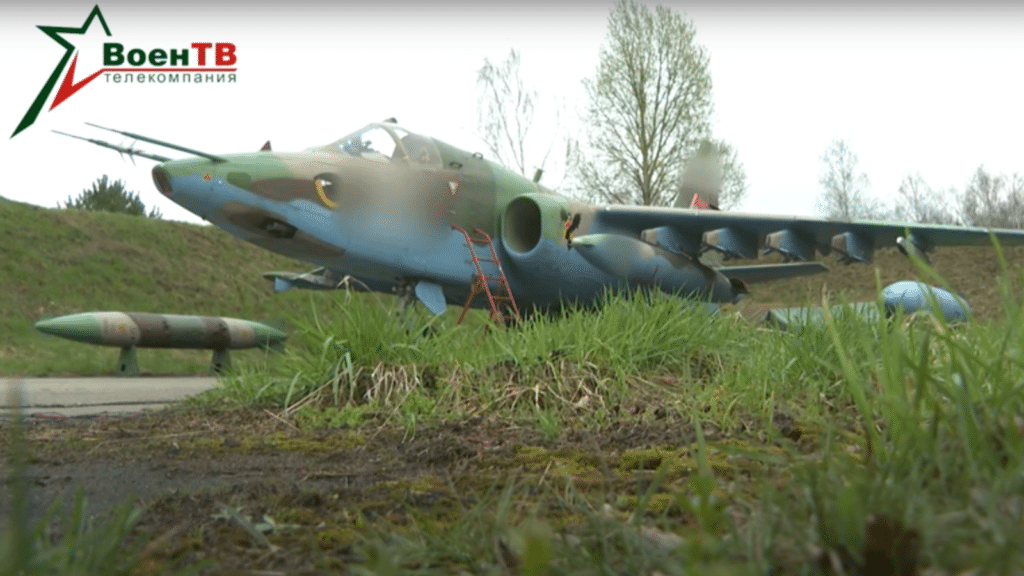We know where Russian nuclear-capable aircraft will be hosted in Belarus. What’s next?
By Matt Korda, Eliana Johns | April 24, 2023
 A Belarusian Su-25 nuclear-capable aircraft sitting at an undisclosed location was shown in a Belarusian TV news clip on April 14, 2023. Using the video and other open-source information, researchers at the Federation of American Scientists confirmed that the Russia-Belarus nuclear sharing mission will most likely be performed from the Lida air base in western Belarus. (Photo: Belarusian Ministry of Defense, via Federation of American Scientists)
A Belarusian Su-25 nuclear-capable aircraft sitting at an undisclosed location was shown in a Belarusian TV news clip on April 14, 2023. Using the video and other open-source information, researchers at the Federation of American Scientists confirmed that the Russia-Belarus nuclear sharing mission will most likely be performed from the Lida air base in western Belarus. (Photo: Belarusian Ministry of Defense, via Federation of American Scientists)
On March 25, in an interview for Russian television, President Vladimir Putin revealed new details about Russia’s intention to establish a NATO-style nuclear sharing relationship with Belarus. During the interview, he said that Russia had already transferred the dual-capable Iskander complex and had helped Belarus modify their aircraft to give them the ability to carry nuclear weapons, adding that “ten planes are ready for using this type of weapon.” The Russian president then gave a timeline for the next steps in this arrangement: “From April 3, we start training crews. And on July 1, we are finishing the construction of a special storage facility for tactical nuclear weapons on the territory of Belarus.”
Putin’s announcement has raised more questions than answers. Although it was already known that Russia had transferred nuclear-capable military equipment to Belarus in 2022, the construction of a “special storage facility” for tactical nuclear weapons on another country’s soil is a new and potentially consequential shift in Russia’s nuclear posture. It comes as no surprise, then, that Putin’s declaration has invited a wealth of attention and speculation.
Putin’s initial reluctance. Russia and Belarus have been publicly discussing the option of nuclear sharing for at least a year and a half. In November 2021, Belarusian President Alexander Lukashenko announced that he would offer Putin the ability to return nuclear weapons to Belarus, stating that “we are ready for this on the territory of Belarus. Nuclear weapons left over from the times of the USSR, approximately all the sheds are in place. […] All the sites on which the Topols stood, except for one, are completely preserved and still ready for use.”
A few months later, Belarus quietly approved changes to its constitution that would allow it to host nuclear weapons on its territory for the first time since the Soviet Union’s Topol mobile ICBMs were removed in 1996.
Despite a publicly enthusiastic Belarus, however, Putin shared his initial reservations about such a deployment, alongside his long-known displeasure at NATO’s own nuclear sharing posture. On June 25, 2022, in a meeting with Lukashenko, Putin railed against the forward-deployment of US nuclear weapons in European NATO countries, agreeing with Lukashenko that “Russia does not have a single base of this kind.” In that same conversation, Putin noted that “we could reciprocate […] but you and we probably should not respond – there is no need.”
Instead, Putin offered Lukashenko a compromise: Russia would re-equip Belarusian Su-25 aircraft with the ability to carry nuclear weapons and transfer Iskander-M tactical missile systems, “which are known to use both ballistic and cruise missiles, both conventional and nuclear,” to Belarus. Six months later, Lukashenko stated that “[W]e are now preparing crews with the Russians capable of flying these aircraft carrying […] special weapons and special ammunition,” and announced that the Russian-supplied Iskanders had been placed on combat duty. In February 2023, the Federation of American Scientists’ Hans Kristensen geolocated the Russian-supplied Iskanders at a training ground near Osipovichi in central Belarus. Shortly after, Russian pilots reportedly completed their “special munitions” training using their newly modified aircraft in Russia.
Putin’s public reversal. Despite Putin stating as recently as the June 2022 meeting with Lukashenko that there was “no need” to reciprocate NATO’s nuclear sharing posture, he is now arguing the exact opposite.
Putin’s March 25 interview, in which he announced the construction of a “special storage facility for tactical nuclear weapons” on Belarusian soil, was a startling about-face. Rather than railing against NATO’s nuclear sharing posture, as he had continuously done for many years, he nearly came close to defending it: “We are not handing over [the weapons]. And the United States does not hand [it] over to its allies. We’re basically doing the same thing they’ve been doing for a decade. They have allies in certain countries and they train their carriers, they train their crews. We are going to do the same thing.”
President Putin also argued that the deployment of nuclear weapons to Belarus would be wholly consistent with Russia’s obligations under the Treaty on the Non-Proliferation of Nuclear Weapons, essentially reversing his decades-old position that NATO’s nuclear sharing posture was incompatible with the Treaty—a position that also ignored the historical record of close US-Soviet cooperation to ensure that NATO’s arrangements were compatible with the Treaty’s obligations at the time of its drafting.
In addition, Putin’s announcement conflicts with a Russian-Chinese joint statement released on March 21—only four days earlier—in which both countries agreed that “all nuclear-weapon states should refrain from deploying nuclear weapons abroad and withdraw nuclear weapons deployed abroad.” One week later, China’s Deputy Permanent Representative to the United Nations called for “the abolition of nuclear sharing arrangements and […] no deployment of nuclear weapons abroad by all nuclear weapons states and the withdrawal of nuclear weapons deployed abroad.”
Knowns and unknowns. It is still highly unclear whether Russia intends to actually deploy nuclear weapons on Belarusian territory, or whether it is developing the infrastructure needed to potentially deploy them in the future. What is clear, however, is that constructing a warhead storage site in Belarus—even if warheads would not be immediately or permanently stored there—would come with significant logistical complications. Other storage sites in Russia have taken years to upgrade—let alone build from scratch. Such an effort would also require lengthy certification processes for both the crews and the specialized equipment.
Moreover, personnel from the 12th GUMO—the department within the Russian Ministry of Defence responsible for maintaining and transporting Russia’s nuclear arsenal—would also necessarily be deployed to Belarus to staff the storage site and would need a segregated living space. Bill Moon of the Nuclear Security Program at the Stimson Center, who has decades of experience working alongside the 12th GUMO, estimates that this could be a contingent of approximately one hundred personnel, including warhead maintainers, guards, and armed response forces. In addition, the majority of the equipment would likely need be transported by rail, where it would inevitably face risks of sabotage by Belarusian and Russian anti-war activists, as well as Ukrainian drone strikes. Finally, if Russia was to actually transport nuclear weapons to Belarus, it would have to do so without inadvertently sending a signal to NATO of imminent nuclear use—especially since the warheads would likely come from storage sites relatively close to the Ukrainian border, such as Bryansk-18.
The military benefits that Russia would derive from deploying nuclear weapons to Belarusian territory are unclear: Belarus’ Su-25 Frogfoot aircraft—which Putin named as those being modified to carry nuclear weapons—are approximately 40 years old and would be highly vulnerable to NATO’s air defense systems. Such a consequential deployment would certainly be a signal to NATO’s eastern flank—particularly Poland, which has been the critical node for transporting NATO weaponry to Ukraine. But any nuclear weapons deployed abroad would also be highly vulnerable. This will be especially true given that our assessment of a recent Belarusian military video indicates that Lida Air Base—located only 40 kilometers from Lithuania’s southern border and approximately 120 kilometers from Poland’s eastern border—is the most likely Belarusian air base that will be tasked with the nuclear sharing mission.
Implications. Russia’s proposed deployment will almost certainly undermine its long-standing goal of pushing the United States to remove its own nuclear weapons from European NATO territory. An estimated 100 US B61 bomb variants continue to be stationed at six bases in five NATO countries, and until recently, public pressure calling for the United States to remove its nuclear weapons from Europe was growing increasingly significant, particularly following the entry into force of the Treaty on the Prohibition of Nuclear Weapons. Russia’s nuclear saber-rattling, however, has stalled progress toward Putin’s stated goal, and the United States has reportedly accelerated the delivery of the B61 to Europe while the US Congress calls for further investments in its domestic nuclear forces.
Putin’s announcement of nuclear sharing with Belarus has only reinvigorated calls for NATO’s nuclear weapon modernization and continued weapons deployments in Europe, without providing Russia with a distinct strategic advantage. Putin’s plan for nuclear sharing will also force Belarus to become increasingly invested in the outcome of Russia’s war in Ukraine. As William Alberque of the International Institute for Strategic Studies has pointed out, the proposed nuclear sharing arrangement would ensure that Russia maintains a permanent military presence on Belarusian soil—a development that Lukashenko had previously long resisted.
While Putin’s proposed nuclear sharing posture shares many similar characteristics with that of NATO, the context is vastly different: Russia’s noncompliance with New START (the last remaining treaty limiting US and Russian strategic nuclear forces), its aggression in Ukraine, and its overall nuclear belligerency has demonstrated a concerning willingness to elevate the risk of nuclear war. Not only would establishing a nuclear sharing arrangement with Belarus have a deleterious effect on the global non-proliferation regime, but many factors also call into question the viability of Putin’s statements and the practicality of their implementation. More details will likely emerge over the coming months as we continue to watch for rhetoric coming out of the Kremlin and observe satellite imagery of potential warhead storage sites.
Together, we make the world safer.
The Bulletin elevates expert voices above the noise. But as an independent nonprofit organization, our operations depend on the support of readers like you. Help us continue to deliver quality journalism that holds leaders accountable. Your support of our work at any level is important. In return, we promise our coverage will be understandable, influential, vigilant, solution-oriented, and fair-minded. Together we can make a difference.
Keywords: Belarus, NATO, NATO-Russia war, Putin, Russia, Russian tactical nuclear weapons, Ukraine, open-source intelligence
Topics: Nuclear Weapons
















Were there not tactical nuclear weapons in Byelarus under the USSR? If so, would their storage facilities not still be there?
It might be argued that Putin wants to utilize the nuclear option but have it come from Belarus rather than Russia in order to spare ‘the motherland’ from a strike. An option might be to let it be known that the west is targeting Minsk, Moscow and the Lida base for any nuclear use originating from Belarus. The citizens of Minsk as well as Moscow should be made aware of such a posture, if there is any way to get such information into either country.